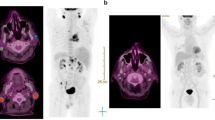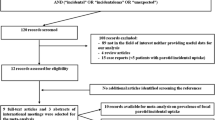Abstract
Objectives
To evaluate the prevalence and clinical significance of focal parotid lesions identified by 18 F- FDG PET/CT in patients with nonparotid head and neck malignancies.
Methods
From 3,638 PET/CT examinations using 18 F-FDG conducted on 1,342 patients with nonparotid head and neck malignancies, we retrospectively identified patients showing incidental focal FDG uptake in the parotid glands. The diagnosis of parotid lesions was confirmed histopathologically or on imaging follow-up. Patient demographics, clinical features, maximum standardized uptake value (SUVmax) on PET images, size and attenuation on corresponding contrast-enhanced CT images were assessed and correlated with the final diagnosis.
Results
The prevalence of incidental focal parotid FDG uptake on PET/CT was 2.1 % (95 % CI 1.4 – 3.0 %). Among 21 patients with focal parotid lesions confirmed histologically or on imaging follow-up, 7 (33.3 %) had malignant lesions (all metastases) and 14 (66.7 %) had benign lesions (four pleomorphic adenomas, two Warthin's tumours, one benign lymph node, one granulomatous lesion, six lesions without histopathological confirmation). There were no significant differences in age, sex, SUVmax or CT findings between patients with benign and those with malignant lesions.
Conclusion
Focal parotid FDG uptake on PET/CT in patients with head and neck malignancy warrants further investigations to ensure adequate therapy for incidental parotid lesions.
Key Points
• The prevalence of parotid incidentaloma on PET in head and neck malignancy was 2.1 %
• The malignancy rate of incidental focal parotid FDG uptake was 33.3 %
• SUV max could not reliably differentiate malignant from benign incidental parotid lesions


Similar content being viewed by others
References
Lin M, Ho Shon I, Lin P (2010) Positron emission tomography: current status and future challenges. Intern Med J 40:19–29
Ishimori T, Patel PV, Wahl RL (2005) Detection of unexpected additional primary malignancies with PET/CT. J Nucl Med 46:752–757
Choi JY, Lee KS, Kwon OJ et al (2005) Improved detection of second primary cancer using integrated [18 F] fluorodeoxyglucose positron emission tomography and computed tomography for initial tumor staging. J Clin Oncol 23:7654–7659
Nakamoto Y, Tatsumi M, Hammoud D, Cohade C, Osman MM, Wahl RL (2005) Normal FDG distribution patterns in the head and neck: PET/CT evaluation. Radiology 234:879–885
Basu S, Houseni M, Alavi A (2008) Significance of incidental fluorodeoxyglucose uptake in the parotid glands and its impact on patient management. Nucl Med Commun 29:367–373
Lee SK, Rho BH, Won KS (2009) Parotid incidentaloma identified by combined 18 F-fluorodeoxyglucose whole-body positron emission tomography and computed tomography: findings at grayscale and power Doppler ultrasonography and ultrasound-guided fine-needle aspiration biopsy or core-needle biopsy. Eur Radiol 19:2268–2274
Wang HC, Zuo CT, Hua FC et al (2010) Efficacy of conventional whole-body 18 F-FDG PET/CT in the incidental findings of parotid masses. Ann Nucl Med 24:571–577
Thomas R, Sharma N, Burke C, Maxwell D, Howlett DC (2010) Parotid incidentaloma detected during thoracic PET imaging: how should these lesions be managed? Br J Hosp Med (Lond) 71:292–293
Campbell M (2005) Confidence intervals and Newcombe's method – what are they? Midwifery 21:80–83
Nakamura S, Okochi K, Murata Y, Shibuya H, Kurabayashi T (2009) [18 F]Fluorodeoxyglucose-PET/CT differentiation between physiological and pathological accumulations in head and neck. Nucl Med Commun 30:498–503
Keyes JW Jr, Harkness BA, Greven KM, Williams DW 3rd, Watson NE Jr, McGuirt WF (1994) Salivary gland tumor: pretherapy evaluation with PET. Radiology 192:99–102
Uchida Y, Minoshima S, Kawata T et al (2005) Diagnostic value of FDG PET and salivary gland scintigraphy for parotid tumors. Clin Nucl Med 30:170–176
Rubello D, Nanni C, Castellucci P et al (2005) Does 18 F-FDG PET/CT play a role in the differential diagnosis of parotid masses? Panminerva Med 47:187–189
Blodgett TM, Fukui MB, Snyderman CH et al (2005) Combined PET-CT in the head and neck. Part 1. Physiologic, altered physiologic, and artifactual FDG uptake. Radiographics 25:897–912
Okamura T, Kawabe J, Koyama K et al (1998) Fluorine-18 fluorodeoxyglucose positron emission tomography imaging of parotid mass lesions. Acta Otolaryngol Suppl 538:209–213
Shah VN, Branstetter BF (2007) Oncocytoma of the parotid gland: a potential false-positive finding on 18 F-FDG PET. AJR Am J Roentgenol 189:W212–W214
Ozawa N, Okamura T, Koyama K et al (2006) Retrospective review: usefulness of a number of imaging modalities including CT, MRI, technetium-99 m pertechnetate scintigraphy, gallium-67 scintigraphy and F-18-FDG PET in the differentiation of benign from malignant parotid masses. Radiat Med 24:41–49
Choi DS, Na DG, Byun HS et al (2000) Salivary gland tumors: evaluation with two-phase helical CT. Radiology 214:231–236
Lev MH, Khanduja K, Morris PP et al (1988) Parotid pleomorphic adenomas: delayed CT enhancement. AJNR Am J Neuroradiol 19:1835–1839
Yerli H, Aydin E, Coskun M et al (2007) Dynamic multislice computed tomography findings for parotid gland tumors. J Comput Assist Tomogr 31:309–316
Shimizu M, Ussmüller J, Hartwein J, Donath K, Kinukawa N (1999) Statistical study for sonographic differential diagnosis of tumorous lesions in the parotid gland. Oral Surg Oral Med Oral Pathol Oral Radiol Endod 88:226–233
Cvetinović M, Jović N, Mijatović D (1991) Evaluation of ultrasound in the diagnosis of pathologic processes in the parotid gland. J Oral Maxillofac Surg 49:147–150
Acknowledgments
The scientific guarantor of this publication is Dae Young Yoon. The authors declare no relationships with any companies whose products or services may have been related to the subject matter of the article. The authors state that this work did not receive any funding. No complex statistical methods were necessary for this study.
Institutional Review Board approval was obtained. Written informed consent was waived by the Institutional Review Board. Methodology: retrospective, observational, performed at one institution.
Author information
Authors and Affiliations
Corresponding author
Rights and permissions
About this article
Cite this article
Seo, Y.L., Yoon, D.Y., Baek, S. et al. Incidental focal FDG uptake in the parotid glands on PET/CT in patients with head and neck malignancy. Eur Radiol 25, 171–177 (2015). https://doi.org/10.1007/s00330-014-3397-1
Received:
Revised:
Accepted:
Published:
Issue Date:
DOI: https://doi.org/10.1007/s00330-014-3397-1




